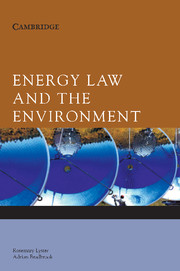Book contents
- Frontmatter
- Contents
- List of figures & tables
- Table of cases
- Table of statutes
- Preface
- 1 Overview of energy production and use in Australia
- 2 Energy technologies and sustainable development
- 3 Energy, international environmental law and sustainable development
- 4 Predicting the RPP for any given year
- 5 Sustainable energy in the Australian electricity and gas sectors
- 6 State government initiatives on energy and the environment
- 7 A sustainable energy law future for Australia
- Appendix A Draft non-legally binding Statement of Principles for a Global Consensus on Sustainable Energy Production and Consumption
- Appendix B Draft Protocol on Energy Efficiency and Renewable Energy to the United Nations Framework Convention on Climate Change
- Index
1 - Overview of energy production and use in Australia
Published online by Cambridge University Press: 05 June 2012
- Frontmatter
- Contents
- List of figures & tables
- Table of cases
- Table of statutes
- Preface
- 1 Overview of energy production and use in Australia
- 2 Energy technologies and sustainable development
- 3 Energy, international environmental law and sustainable development
- 4 Predicting the RPP for any given year
- 5 Sustainable energy in the Australian electricity and gas sectors
- 6 State government initiatives on energy and the environment
- 7 A sustainable energy law future for Australia
- Appendix A Draft non-legally binding Statement of Principles for a Global Consensus on Sustainable Energy Production and Consumption
- Appendix B Draft Protocol on Energy Efficiency and Renewable Energy to the United Nations Framework Convention on Climate Change
- Index
Summary
In this chapter, a brief overview of current energy production and use in Australia is provided, including projections of future energy needs and the likely future mix of energy sources. This is done to establish the context within which to discuss, in later chapters, how the law is responding to the environmental problems created by Australia's energy profile. What emerges is that Australia is, and will likely remain, a country heavily dependent on fossil fuels. Under current regulatory arrangements, renewable sources of energy are likely to make an insignificant contribution to the overall energy mix in future. Although a debate on the role of nuclear energy in Australia has begun, it is too soon to speculate where that debate might lead. The emissions of carbon dioxide from the burning of fossil fuels contribute significantly to the threat of global climate change. Consequently, this book is devoted, in the main, to analysing Australia's regulatory framework for controlling these emissions, and provides a comparative analysis of developments in other jurisdictions against which to compare the efforts of governments in Australia.
Energy production and trade in Australia
In 2003, the Australian Bureau of Statistics conducted an Energy Survey 2001–02 to collect data on energy use across sectors of the Australian economy, excluding agriculture, forestry, fishery and residential sectors. This information has been used by the Australian Bureau of Agricultural and Resource Economics (ABARE) to undertake its own 2003–04 fuel and electricity survey.
- Type
- Chapter
- Information
- Energy Law and the Environment , pp. 1 - 9Publisher: Cambridge University PressPrint publication year: 2006



